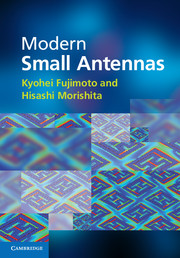Book contents
- Frontmatter
- Contents
- Preface
- Acknowledgements
- 1 Introduction
- 2 Small antennas
- 3 Properties of small antennas
- 4 Fundamental limitations of small antennas
- 5 Subjects related with small antennas
- 6 Principles and techniques for making antennas small
- 7 Design and practice of small antennas I
- 8 Design and practice of small antennas II
- 9 Evaluation of small antenna performance
- 10 Electromagnetic simulation
- 11 Glossary
- Index
- References
4 - Fundamental limitations of small antennas
Published online by Cambridge University Press: 05 January 2014
- Frontmatter
- Contents
- Preface
- Acknowledgements
- 1 Introduction
- 2 Small antennas
- 3 Properties of small antennas
- 4 Fundamental limitations of small antennas
- 5 Subjects related with small antennas
- 6 Principles and techniques for making antennas small
- 7 Design and practice of small antennas I
- 8 Design and practice of small antennas II
- 9 Evaluation of small antenna performance
- 10 Electromagnetic simulation
- 11 Glossary
- Index
- References
Summary
Fundamental limitations
It is commonly understood that as antennas reduce in size, antenna gain and efficiency will degrade and the bandwidth tends to be narrower. Then, a question arises how small a dimension an antenna can take for practical use? Or, what will happen when the antenna dimension is limitlessly reduced? One answer was given by J. D. Kraus, who showed that a small antenna could have effective aperture of as high as 98 percent of that of a half-wave dipole antenna, if the antenna could be perfectly matched to the load [1]. It suggests that however small an antenna is, the antenna can intercept almost the same power (only 8 percent less) as a half-wavelength dipole does. In other words, there seems to be no limitation in reducing the antenna size so long as the antenna could be perfectly matched. Unfortunately, the perfect matching is impossible when an antenna becomes extremely small, because the smaller the antenna size tends to be, the harder the antenna matching will become, as was mentioned before. In addition, losses existing in the antenna structure and the matching circuit will exceed the radiation resistance, resulting in significant reduction of the effective aperture that corresponds to reduction of the radiation power and the degradation of the radiation efficiency. Regarding the antenna impedance, increase in reactive component and decrease in the resistive component results in high Q, and as a consequence bandwidth will be narrowed. Thus, the size reduction of an antenna also affects Q and the bandwidth as well. Then it is rather natural to say that there is a fundamental limitation applying to the size reduction of antenna dimensions.
- Type
- Chapter
- Information
- Modern Small Antennas , pp. 23 - 38Publisher: Cambridge University PressPrint publication year: 2014



